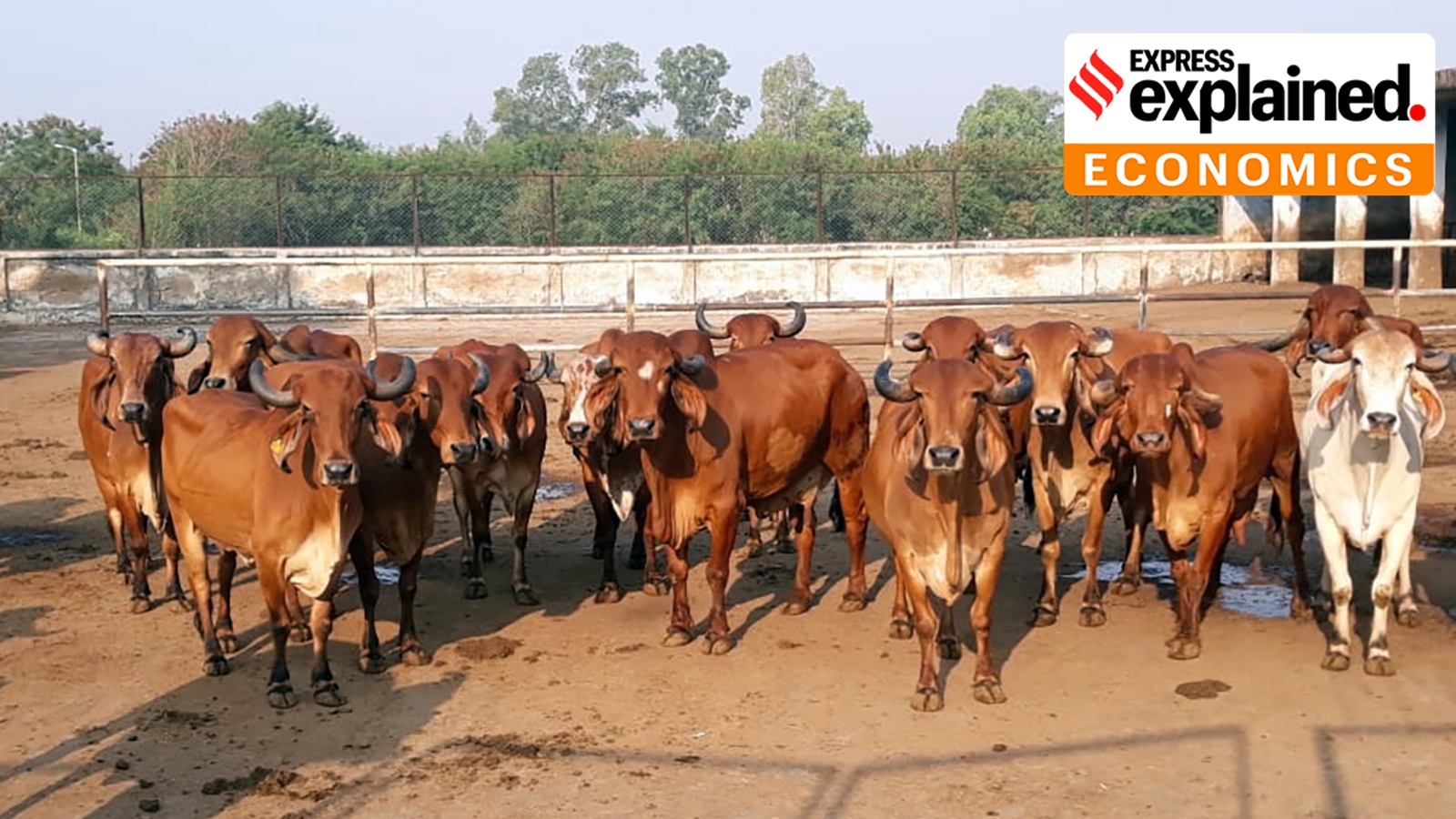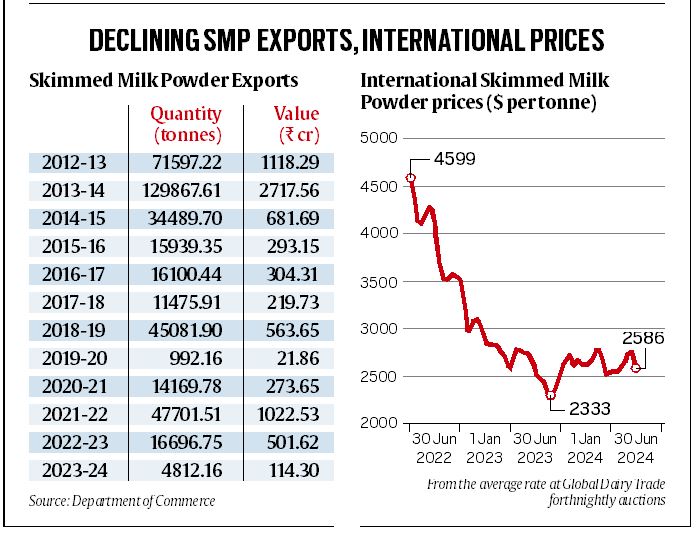How surplus milk powder is the dairy trade’s new downside | Defined Information

With many states imposing stringent anti-slaughter regulations, Indian dairy farmers are going through demanding situations in doing away with unproductive livestock — the ones that don’t produce sufficient milk or are male.
Now, they’re confronted with a brand new “extra” downside of skimmed milk powder (SMP). Cooperative and personal dairies have an estimated 3-3.25 lakh tonnes (lt) of SMP inventory in the beginning of the manufacturing 12 months that runs from July to June.
Here is why there is a surplus in SMP inventory, why it issues, and what a conceivable answer might be.
However first, what’s SMP?
Cow milk accommodates on a mean 3.5% fats and eight.5% solids-non-fat (SNF), whilst buffalo milk accommodates 6.5% and 9%. Milk can’t be stocked as it’s perishable. After keeping apart the cream and drying the skimmed milk, handiest its solids (i.e. fats and SNF) can also be saved.
Right through the “flush” season, when livestock and buffaloes produce extra, dairies convert the surplus milk they obtain into butter, ghee and SMP – the primary two from cream/fats and the ultimate from SNF. Those solids are mixed with water to transform into liquid milk throughout the “lean” season, when manufacturing by means of animals is low and will not be sufficient to fulfill call for.
Within the south and Maharashtra (states with upper numbers of cows), the flush season normally runs from July to December, following the southwest monsoon rains. Within the north and Gujarat, it runs from September to March (this may be the time when buffalo calves are born, because the area has upper numbers of cows).
From each and every 100 litres (or 103 kg) of cow milk, a dairy could make about 8.75 kg of SMP (at 8.5% SNF) and three.6 kg of ghee (at 3.5% fats).
So then what’s the downside of surplus in SMP?
The issue arises when dairies purchase extra milk – over and above the standard surplus throughout flushes – and the SMP and butter/ghee produced don’t in finding many patrons.
Dairies in India produce 5.5-6 litres of SMP every year. A big portion of this, about 4 litres, is used for reprocessing throughout the tilt season. The rest 1.5-2 litres is fed on by means of producers of ice cream, biscuits, sweets, candies, child components and different meals and business merchandise.
2023-24 used to be a 12 months of considerable and constant milk provide, with rarely any shortages. This used to be by contrast to 2022-23, which noticed exceptional shortages. Dairies in Maharashtra accomplished file costs of Rs 430-435 in keeping with kg for yellow (cow) butter and Rs 315-320 for SMP throughout February-March 2023. They paid farmers Rs 37-38 in keeping with litre for cow milk with 3.5% fats and eight.5% SNF, encouraging them to extend manufacturing by means of higher feeding and including new animals.
The ensuing higher milk availability, together with throughout the height summer season months of April-June, intended that hardly 2.5 litres of SMP used to be fed on for reconstitution functions. As a substitute of the standard beginning inventory of one.5-1.75 litres in July, dairies now have 3-3.25 litres of SMP. With the brand new flush season beginning – and anticipated to top after September, when buffaloes will produce much more milk – the excess downside may just get even worse.
What has been the affect of the excess thus far?
The realisation of cow SMP for dairies has fallen to Rs 200-210 in keeping with kg and for yellow butter to Rs 335-340. The latter corresponds to a ghee value of Rs 408-415 in keeping with kg (ghee accommodates just about 100% fats, whilst butter has 82% fats).
Alternatively, milk fats is much less of a surplus downside, as its annual manufacturing by means of dairies is handiest 3-3.5 litres. In contrast to SMP, fats additionally has a excellent marketplace in India, each amongst families and business customers. That is much more so throughout the grand festive months of August to November, when intake will increase. Cakes is going on most sensible. Base elements – Ghee, Khoya, chenna and paneer — Maximum Indian candies are produced from high-fat milk. Therefore, there’s a upper likelihood of correction in fats costs than SMP.
As in keeping with present in keeping with kg receipts, the gross income for a dairy generating 8.75 kg SMP and three.6 kg fats/ghee from 100 litres of cow milk could be Rs 3,224-3,333. After deducting post-purchase bills of Rs 350 (on cooling, aggregator/assortment agent fee and transportation to the plant) and processing and packing prices of Rs 350, the utmost the dairy will pay farmers is Rs 2,524-2,633 or Rs 25.24-26.33 in keeping with litre. And that is kind of what they’re paying.
Politically, this generally is a crisis – particularly forward of the Maharashtra state meeting elections in October. The Nationwide Democratic Alliance govt there on June 28 introduced a subsidy of Rs 5 in keeping with litre on milk provided by means of farmers to dairies. Alternatively, the finer main points of the scheme – eligibility standards and protection of farmers in addition to dairies – are nonetheless awaited. Even supposing it’s carried out in time for the elections, it is going to now not clear up the underlying downside of piling up SMP shares.
Is there a greater answer?
Ganesan Palaniappan, a Chennai-based dairy inputs dealer, believes the one strategy to do away with extra SMP inventory is to export it, both commercially or as commodity assist to neighbouring international locations.
However falling international costs — SMP charges at the New Zealand-based World Dairy Industry fortnightly on-line public sale platform are buying and selling at $2,586 a tonne in April 2022, down from a contemporary excessive of $4,599 — make industrial exports unviable. Additionally, India’s SMP shipments are set to say no, from 1.3 litres in 2013-14 to 4,800 tonnes in 2023-24. (See chart and desk),
“The Centre must supply subsidy on SMP exports, which is able to elevate home costs and permit our dairies to pay extra to farmers,” Palaniappan stated.
RS Sodhi, president of the Indian Dairy Affiliation, advised that the central govt create a buffer inventory of fifty,000-100,000 tonnes of SMP: “If farmers don’t get remunerative costs, they received’t be capable to feed their cattle correctly, and subsequent 12 months you’re going to have milk inflation. The buffer inventory (the federal government buys the powder from dairies and likewise will pay for its garage) will give a boost to costs for manufacturers now and offer protection to customers from long run inflation.”
Within the medium time period, the dairy trade will have to expand markets for SMP or its elements – proteins (casein and whey), carbohydrates (lactose), and minerals (basically calcium, potassium, and phosphorus).
There are two causes for this. First, the call for for milk fats is rising in India. However for each and every 1 kg of fats, dairies produce greater than 2.4 kg of SMP. 2nd, farmers wish to rear cows as a result of they – regardless of problems associated with disposal of unproductive livestock – give extra milk and get started generating calves quicker than buffaloes. However, 1 kg of fats from buffalo milk leads to the manufacturing of not up to 1.4 kg of SMP.
Since a big portion of milk in India comes from cows, the problem of discovering a marketplace for surplus SMP might also building up.
Supply hyperlink
#surplus #milk #powder #dairy #industrys #downside #Defined #Information






